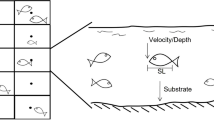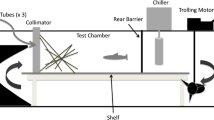Abstract
Macoma balthica (L.), an abundant clam, ubiquitous in temperate estuaries across the North Atlantic, is known to practice both alternative basic modes of feeding available to seafloor invertebrates. It either holds its feeding organ, the siphon, at a fixed position just above the sediment surface to filter out food particles suspended in the overlying water or else extends and moves its siphon around to vacuum up deposited food particles on the sediment surface. Previous laboratory experiments have established an understanding of the role of current flow in dictating the choice of whether suspension or deposit feeding will be used by marine invertebrates with the facultative flexibility to choose. Faster flows imply greater fluxes of suspended particles so that the energetic rewards of suspension feeding are enhanced. Slower flows imply reduced renewal rates of suspended foods in the bottom boundary layers and enhanced deposition of food particles on the seafloor so that a switch to deposit feeding is favored. Like early optimal foraging theory, this understanding is based on energetic considerations alone without incorporation of broader implications of how population interactions such as predation and competition influence individual foraging behavior. Feeding behavior of Macoma balthica is influenced in the Neuse River estuary by both hydrodynamics and siphon-cropping by juvenile demersal fishes. Under conditions of identical concentrations of suspended particulates in the water column and organic contents of surface sediments, Macoma exhibited much higher levels of deposit feeding where currents were slower. In addition, exclosure and fish inclosure experiments demonstrated that juvenile demersal fishes influence feeding behavior of Macoma by cropping exposed siphons and inducing reduction in deposit-feeding activity. Effects of croppers were substantial in early to midsummer, when juvenile fish abundances were greatest in trawl samples from this estuarine nursery and before the growing fish exhibited ontogenetic changes in diet away from early concentration on bivalve siphons. Field experiments in which siphon-cropping fish were caged at varying distances off the bottom failed to detect any effective behavioral avoidance by Macoma of cropping in response to proximity of fish. One might have hypothesized that under high risk of cropping, Macoma would switch to suspension feeding and away from deposit feeding, the feeding method entailing more risk of losses to croppers because of greater siphon activity and greater extension of siphons on the sediment surface. Consequently, partial predation by siphon-cropping fishes greatly reduces deposit-feeding activity by Macoma balthica during summer as an apparent direct effect of disfigurement and reduction of siphons, the organ required for efficient deposit feeding. Information on current flows alone would not suffice to predict feeding behavior of this marine invertebrate: the influence of partial predation must also be included.
Similar content being viewed by others
References
Ansell AD, Trevallion A (1967) Studies on Tellina tenuis Da Costa. I. Seasonal growth and biochemical cycle J Exp Mar Biol Ecol 1:220–235
Appleton RD, Palmer AR (1988) Water-borne stimuli released by predatory crabs and damaged prey induce more predator-resistant shells in a marine gastropod. Proc Natl Acad Sci USA 85:4387–4391
Blundon JA, Kennedy VS (1982) Refuges for infaunal bivalves from blue crab, Callinectes sapidus, predation in Chesapeake Bay. J Exp Mar Biol Ecol 65:67–82
Brafield AE, Newell GE (1961) The behaviour of Macoma balthica. J Mar Biol Assoc UK 41:81–87
Bubnova NP (1972) The nutrition of the detritus-feeding molluscs Macoma balthica (L.) and Portlandia arctica (Gray) and their influence on bottom sediments. Oceanology 12:899–905
Burrows MT, Hughes RN (1991) Optimal foraging decisions by dogwhelks, Nucella lapillus (L.): influences of mortality risk and rate-constrained digestion. Funct Ecol 5:461–475
Currin BM, Reed JP, Miller JM (1984) Growth, production, food consumption, and mortality of juvenile spot and croaker: a comparison of tidal and nontidal nursery areas. Estuaries 7:451–459
Elner RW, Hughes RN (1978) Energy maximization in the diet of the shore crab, Carcinus maenas. J Anim Ecol 47:103–116
Fauchald K, Jumars PA (1979) The diet of worms: an analysis of polychaete feeding guilds. Oceanogr Mar Biol Annu Rev 17:193–284
Folk RL (1980) Petrology of sedimentary rocks, 2nd edn Hemphill, Austin
Gray JS (1974) Animal-sediment relationships. Oceanogr Mar Biol Annu Rev 12:223–261
Harvell CD (1990) The ecology and evolution of inducible defenses. Q Rev Biol 65:323–340
Hay ME, Fenical W (1988) Marine plant-herbivore interactions: the ecology of chemical defense. Annu Rev Ecol Syst 19:111–145
Hines AH, Posey MH (1989) Complex trophic interactions in estuarine food webs: jargon, concepts and examples. Am Zool 29:27
Hines AH, Haddon AM, Wiechert LA (1990) Guild structure and foraging impact of blue crabs and epibenthic fish in a subestuary of Chesapeake Bay. Mar Ecol Prog Ser 67:105–126
Hodgson AN (1982) Studies on wound healing, and an estimation of the rate of regeneration, of the siphon of Scrobicularia plana. J Exp Mar Biol Ecol 62:117–128
Holbrook SJ, Schmitt RJ (1988) The combined effects of predation risk and food reward on patch selection. Ecology 69:125–139
Houston AI, Clark C, McNamara JM, Mangel M (1988) Dynamic models in behavioural and evolutionary ecology. Nature 332:29–34
Hughes RN (1980) Optimal foraging in the marine context. Oceanogr Mar Biol Annu Rev 18:423–481
Hughes RN, Roberts DJ (1980) Reproductive effort in winkles (Littorina spp.) with contrasted methods of reproduction. Oecologia 47:130–136
Huitema BE (1980) The analysis of covariance and its alternatives. Wiley-Interscience, New York
Hulscher JB (1982) The oystercatcher as a predator of Macoma. Ardea 70:89–152
Hummel H (1985) Food intake of Macoma balthica (Mollusca) in relation to seasonal changes in its potential food on a tidal flat in the Dutch Wadden Sea. Neth J Sea Res 19:52–76
Irlandi EA, Peterson CH (1991) Modification of animal habitat by large plants: mechanisms by which seagrasses influence clam growth. Oecologia 87:307–318
Kenny DA, Judd CM (1986) Consequences of violating the independence assumption in analysis of variance. Psych Bull 99:422–431
Lawton P (1987) Diel activity and foraging behaviour of juvenile American lobsters, Homarus americanus. Can J Fish Aquat Sci 44:1195–1205
Levinton JS (1971) Control of tellinacean (Mollusca: Bivalvia) feeding behavior by predation. Limnol Oceanogr 16:660–662
Levinton JS (1991) Variable feeding behavior in three species of Macoma (Bivalvia: Tellinacea) as a response to water flow and sediment transport. Mar Biol 110:375–383
Levinton JS, Lopez GR (1977) A model of renewable resources and limitation of deposit-feeding benthic populations Oecologia 31:177–190
Lima SL, Dill LM (1990) Behavioural decisions made under the risk of predation: a review and prospectus. Can J Zool 68:619–640
Lin J, Hines AH (1994) Effects of suspended food availability on the feeding mode and burial depth of the Baltic clam, Macoma balthica. Oikos 69:28–36
Mangel M, Clark CW (1986) Towards a unified foraging theory. Ecology 67:1127–1138
Mangel M, Clark CW (1988) Dynamic modeling in behavioral ecology. Princeton University Press, Princeton
McNamara JM, Houston AI (1986) The common currency for behavioral decisions. Am Nat 127:372–374
Milinski M (1990) Information overload and food selection. In: Hughes RN (ed) Behavioural mechanisms of food selection. Springer, Berlin, Heidelberg New York pp 721–737
Neter J, Wasserman W, Kutner MH (1990) Applied linear statistical models. Irwin, Boston
Nowell ARM, Jumars PA (1984) Flow environments of aquatic benthos. Annu Rev Ecol Syst 15:303–328
Olafsson EB (1986) Density dependence in suspension-feeding and deposit-feeding populations of the bivalve Macoma balthica: a field experiment. J Anim Ecol 55:517–526
Penry DL, Jumars PA (1987) Modeling animal guts as chemical reactors. Am Nat 129:69–96
Peterson CH (1983) A concept of quantitative reproductive senility: application to the hard clam, Mercenaria mercenaria (L.)? Oecologia 58:164–168
Peterson CH, Black R (1987) Resource depletion by active suspension feeders on tidal flats: influence of local density and tidal elevation. Limnol Oceanogr 32:143–166
Peterson CH, Quammen ML (1982) Siphon nipping: its importance to small fishes and its impact on growth of the bivalve Protothaca staminea (Conrad). J Exp Mar Biol Ecol 63:249–268
Peterson CH, Ambrose WG Jr, Hunt JH (1982) A field test of the swimming response of the bay scallop (Argopecten irradians) to changing biological factors. Bull Mar Sci 32:939–944
Reading CJ, McGrorty S (1978) Seasonal variations in the burying depth of Macoma balthica (L.) and its accessibility to wading birds. Estuar Coast Mar Sci 6:135–144
Roelofs EW, Bumpus DF (1953) The hydrography of Pamlico Sound. Bull Mar Sci Gulf Caribbean 3:181–205
Rhoads DC (1974) Organism-sediment relations on the muddy sea floor. Oceanogr Mar Biol Annu Rev 12:263–300
Rhoads DC, Young DK (1970) The influence of deposit-feeding organisms on sediment stability and community trophic structure. J Mar Res 28:150–178
Sanders HL (1958) Benthic studies in Buzzards Bay. I. Animalsediment relationships. Limnol Oceanogr 3:245–258
Schmitt RJ, Holbrook SJ (1985) Patch selection by juvenile black surfperch (Embiotocidae) under variable risk: interactive influence of food quality and structural complexity. J Exp Mar Biol Ecol 85:269–285
Sih A (1986) Antipredator responses and the perception of danger by mosquito larvae. Ecology 67:434–441
Skilleter GA, Peterson CH (1994) Control of foraging behavior of individuals within an ecosystem context: the clam Macoma balthica and interactions between competition and siphon cropping. Oecologia 100:268–278
Spight TM, Emlen J (1976) Clutch sizes of two marine snails with a changing food supply. Ecology 57:1162–1178
Stephens DW, Krebs JR (1986) Foraging theory. Princeton University Press, Princeton
Taghon GL (1981) Beyond selection: optimal ingestion rate as a function of food value. Am Nat 118:202–214
Taghon GL, Jumars PA (1984) Variable ingestion rate and its role in optimal foraging behavior of marine deposit feeders. Ecology 65:549–558
Taghon GL, Nowell ARM, Jumars PA (1980) Induction of suspension feeding in spionid polychaetes by high particle fluxes. Science 210:562–564
Tenore KR (1970) Macrobenthos of the Pamlico River estuary, North Carolina. Ecol Monogr 40:51–69
Trevallion A (1971) Studies on Tellina tenuis da Costa. III. Aspects of general biology and energy flow. J Exp Mar Biol Ecol 7:95–122
Trevallion A, Edwards RRC, Steele JH (1970) Dynamics of a benthic bivalve. In: Steele JH (ed) Marine food chains. University at California Press, Berkeley, pp 285–295
Tunnicliffe V, Risk MJ (1977) Relationships between the bivalve Macoma balthica and bacteria in intertidal sediments: Minas Basin, Bay of Fundy. J Mar Res 35:499–507
Underwood AJ (1981) Techniques of analysis of variance in experimental marine biology and ecology. Oceanogr Mar Biol Annu Rev 19:513–605
Virnstein RW (1977) The importance of predation by crabs and fishes on benthic infauna in Chesapeake Bay. Ecology 58:1199–1217
Vlas J de (1979) Annual food intake by plaice and flounder in a tidal flat area in the Dutch Wadden Sea, with special reference to consumption of regenerating parts of macrobenthic prey. Neth J Sea Res 13:117–153
Weissburg MJ, Zimmer-Faust RK (1993) Life and death in moving fluids: hydrodynamic effects on chemosensory-mediated predation. Ecology 74:1428–1443
Werner EE, Gilliam JF, Hall DJ, Mittelbach GG (1983) An experimental test of the effects of predation risk on habitat use in fish. Ecology 64:1540–1548
Williams AB, Posner WJ, Woods WJ, Deubler EE (1973) A hydrographic atlas of larger North Carolina sounds (Sea Grant Publication, UNC-SG-73-02, UNC Sea Grant College Program). NC State University Raleigh
Winer BJ (1971) Statistical principles in experimental design. McGraw-Hill Kogakusha, Tokyo
Woodin SA (1984) Effects of browsing predators: activity changes in infauna following tissue loss. Biol Bull 166:558–573
Zwarts L (1986) Burying depth of the benthic bivalve Scrobicularia plana (da Costa) in relation to siphon cropping. J Exp Mar Biol Ecol 101:25–39
Zwarts L, Wanink J (1989) Siphon size and burying depth in depositand suspension-feeding benthic bivalves. Mar Biol 100:227–240
Zwarts L, Blomert AM, Wanink JH (1992) Annual and seasonal variation in the food supply harvestable by knot Calidris canutus staging in the Wadden Sea in late summer. Mar Ecol Prog Ser 83:129–140
Author information
Authors and Affiliations
Rights and permissions
About this article
Cite this article
Peterson, C.H., Skilleter, G.A. Control of foraging behavior of individuals within an ecosystem context: the clam Macoma balthica, flow environment, and siphon-cropping fishes. Oecologia 100, 256–267 (1994). https://doi.org/10.1007/BF00316953
Received:
Accepted:
Issue Date:
DOI: https://doi.org/10.1007/BF00316953




